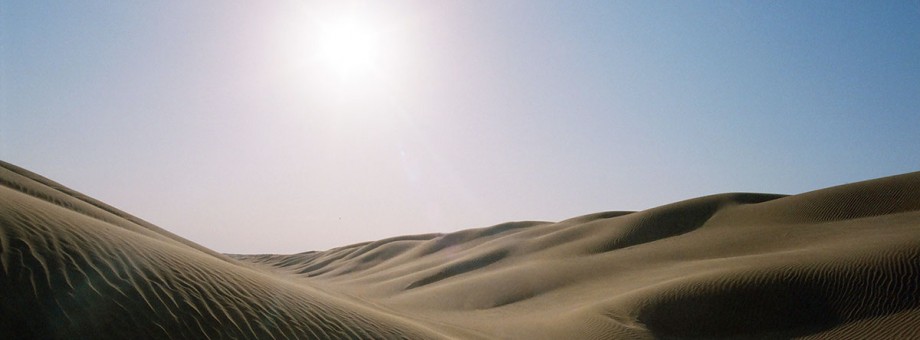Karakum Desert: Unique biosystem and natural attraction

The Karakums is like a patchwork quilt made of different types of deserts like sand, loess, muddy, stone, rubbly and salt. This is an endless plain stretching until the horizon bordered from the south by picturesque rocks and gorges of Kopetdag Mountains, which break off from the height to hilly foothills, after which the desert itself begins. You can see the lakes and parts of dry subtropics, lifeless stone, muddy and gypsum plains, huge territories of loose sands. Central and Eastern Karakums, deltas of Murgab and Tejen Rivers, Sundukly Desert on the right bank of the Amudarya, sand massif Uch Tagan look similar. The spaces between Murgab, Tejen and Amudarya valleys, places to the north off Badhyz and Karabyl, Southwestern Turkmenistan or northeast part of the country are represented by non-repeating landscapes.
If someone has visited the desert once, he would always tries to come again among hot loose sands where the life comes only after the sunset. Memories of the purest desert air, which excellently adsorbs and clean Karakum sand, is associated with the taste of salt winds, bitter smell of desert vegetation, rustling of the reed at several blue lakes. Endless barkhans and their ridges are the most common shape of the desert in Central Karakums. Northern desert steppes with low grass are another hypostasis of the desert that surrounds the chain of lakes Sarykamysh, Zenghi – Baba and other. In these places, salty heathlands might interchange with high-standing saxaul desert forests.
The variety of Karakum Desert will be shortly appreciated by the participants of International rally Amul – Hazar 2018, which will cross Turkmenistan from east to west very shortly in September. They will familiarize themselves with natural attractions and archaeological monuments of past epochs as well as will be able to see rare natural phenomena, unforgettable bright sunsets and sunrises in the desert, will learn about contrast scale of day and night temperatures, will see natural habitats of rare animals and plants.
Being the main part of the route of the rally, Karakum Desert is to attract the attention of the world community to this unique ecosystem, which deserves to be entered to the UNESCO World Heritage List. Racing teams will have rare opportunities to come over the sand parts of untouched wildlife.
Dense solid soils like buried chafed takyrs, salty and dried dense muds, gravel layers as well as soft saline or loose sandstone, porous grounds are located under the layer of Karakum sands. There are loose ridges above them, which links stretch for dozens of kilometres with some barkhans reaching 30 or more meters in height.
Very bright and red-hot almost half of the year, they pour hot sand particle after particle and are able to move their locations in active wind zones. Eolithic material is often in free movement; it always moves, twists in combs of barkhans, goes down from the golden hills and changes the landscape making sand veil in the air covering the horizon with cloudy shroud and picturing the illusion for tired traveller. Due to strong winds, average sand dune in Central Karakums is able to move travelling up to 6 meters per year.
Desert nature is full of contrasts. It turns in bloom in spring being covered with bright carpet of grass and turns in dry wasteland by the summer. It turns to life again with the first autumn rains and seems lifeless in winter due to severe cold. Many plants are ideally adapted in order to bear high temperatures and dry air in summer and freeze in winter. The ephemerals manage to produce the seeds to the beginning of summer.
“Who has never been in desert, do not know the world” – the oriental wisdom says. The subsoils of the Karakums have rich deposits of natural reserves as well as water reserves despite the absence of water on the surface. The nature helps to find fresh or salt water under the ground, one just need to look at the composition of vegetation with attention. For example, the white saxaul dies on salted soil while the black saxaul grows very well on moderately salted soils. The salt in ground water will be demonstrated by the halophytes unlike the shallow grass that prefers fresh water.
Life of desert nature in Turkmenistan is studied at two natural protection territories. Repetek Biosphere Preserve works for more than 90 year. Almost one third of the plants there are original species of local flora while six of them are local endemics. The rodents are the most common among the mammals, round-head lizards, Central Asian turtle and arrow snake among the reptiles. Flying fauna is represented by hundreds of birds in different seasons. There are hundreds species of invertebrates. The history of Repetek Preserve is more than 100 years old. Russian Imperial Geographical Society and its Vice-president, famous traveller P. P. Semenov – Tyan- Shansky were the founder of this unique desert scientific centre. Later, soil scientist V. V. Dokuchayev, geologist and geographer V. A. Obruchev, the father of Russian genetics N. I. Vavilov, mineralogist A. G. Fersman, geomorphologist B. A. Fedorovich, founder of unique Ashgabat Scientific and Research Institute of Study and Development of Deserts (National Institute of Deserts, Flora and Fauna at present) A. G. Babayev, writer J. Darrel as well as biologist N. N. Drozdov have been working there.
Bereketly – Karakum is the second desert preserve. It was opened in 2013 in the north of Ahal Velayat on the area of more than 87 thousand hectares. Natural ecosystem includes the parts of sand, loamy and saline desert as well as their various combinations and is the main place of nesting of Saker falcon. Golden eagle, one-curlew, goitered gazelle, which are in the Red Book of Turkmenistan, can be met within natural protection territory. Unique desert flora is composed of rare species of Sogdiana tulip, astragalus, Karakum ferula and other.


 NEWS
NEWS